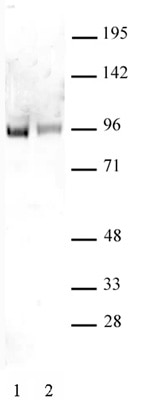Sp1 non-phospho antibody (pAb)
Host / Isotype
Rabbit / IgG
Reactivity
Human
Applications
WB
Cat No : 39809,39810 39809
Synonyms
Validation Data Gallery
Product Information
| Tested Applications |
WB
Applications Validated by Active Motif: WB: 1:500 - 1:1,000 dilution |
| Tested Reactivity | Human |
| Host / Isotype | Rabbit / IgG |
| Class | Polyclonal |
| Type | Antibody |
| Immunogen | This Sp1 antibody was raised against a peptide containing serine 101 of human Sp1. |
| Full Name | Sp1 non-phospho antibody (pAb) |
| Synonyms | Sp1, Sp-1, Sp 1, pAb, polyclonal, antibody, antibodies, transcription, transcriptional activation, specificity protein 1, dna damage, ATM, atm phospho ser1981, atr, double strand break, dsb, non-phospho, sample, dbdabs |
| Molecular weight | 96 kDa |
| GenBank accession number | NP_612482 |
| RRID | AB_2793349 |
| Purification Method | Affinity Purified |
| Buffer | Purified IgG in 70 mM Tris (pH 8), 105 mM NaCl, 31 mM glycine, 0.07 mM EDTA, 30% glycerol and 0.035% sodium azide. Sodium azide is highly toxic. |
| Storage | Some products may be shipped at room temperature. This will not affect their stability or performance. Avoid repeated freeze/thaw cycles by aliquoting items into single-use fractions for storage at -20°C for up to 2 years. Keep all reagents on ice when not in storage. |
Background Information
Sp1 (specificity protein 1) is a human transcription factor involved in gene expression in the early development of an organism. The protein is 785 amino acids long, with a molecular weight of 81 kDa. The Sp1 transcription factor contains a zinc finger protein motif, by which it binds directly to DNA and enhances gene transcription. Its zinc fingers are of the Cys2/His2 type and bind the consensus sequence 5′-(G/T)GGGCGG(G/A)(G/A)(C/T)-3′ (GC box element). It was discovered in 1983 and has since been modified to form Sp1C, which has a zinc finger protein DNA binding domain. Sp1 contains two SQ/TQ domains, which are found in proteins phosphorylated by the DNA-damage response transducer/effector kinase ATM. Phosphorylation of serine 101 (dependent upon ATM and ATR) is stimulated by double strand DNA breakage (DSBs) as well as by blocks to DNA replication induced by treatment with hydroxyurea or UV irradiation. Sp1 phospho Ser101 co-localizes with ATM phospho Ser1981 at DSBs, suggesting that this phosphorylated version of Sp1 plays a role in double strand break repair.

